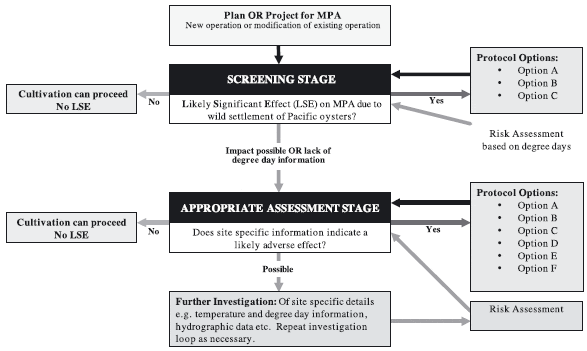FIFG Study
The project was a collaboration between Natural England, Countryside Council for Wales and Environment and Heritage Service (NI), together with industry, the SAGB, ASSG, DARD (NI) and the Aquaculture Initiative. The background to this work was reviewed in Shellfish News Number 25 but can be summarised as follows:
“To produce a Protocol that provides a framework and template under which a process can be identified to help in decision making with respect to Pacific oyster cultivation proposals in or around MPAs with specific reference to any potential environmental impacts on designated features of MPAs through wild settlement of Pacific oysters.”
The main aims of this project were first to produce a Technical Report that would then act as a comprehensive reference source for a first version of a Protocol. Both these reports have been completed and are available for download from the Seafish website (see Further Information).
Technical Report
The Technical Report provides the following information:
-
A review of the background to the issues surrounding wild settlement of Pacific oysters and includes sections reviewing non-native and legislative issues.
-
Consideration as to whether farm and culture type by region may play a role in influencing wild settlement. This included an in-depth investigation of one South West of England estuary where wild settlement has been observed.
-
An overview of hatchery development of Pacific oysters in the UK and a review of the potential for use of triploid oysters, including possibilities for tetraploid development by British hatcheries.
-
Case studies from Australia and France covering the industry development and issues surrounding the introduction of the Pacific oyster.
-
A review of on-going research work with respect to wild settlement of Pacific oysters. The main purpose however of the Technical Report was to establish a basis for, and to help describe, the varied seawater temperature profiles around the UK and through this to assess the likelihood of Pacific oyster recruitment matched against some actual observations of recruitment. Degree day conditions were considered to be the best option available at present to assess the risk of recruitment and the occurrence of wild Pacific oysters, now and in the future.

Risk Assessment
Once the various UK temperature profiles had been described, the Technical Report assigned a geographic risk assessment of the likelihood of Pacific oysters spawning and successfully recruiting in a given region based on current and future predicted seawater temperature profiles i.e. to account for climate change predictions. Regions were classed as Low, Medium or High Risk depending on their temperature profiles relative to the degree day conditions needed for settlement. Low Risk regions with respect to wild settlement currently include Scotland and North East England; Medium Risk regions include Northern Ireland, Wales and South West England; High Risk regions are Southern England and South East England.
The analysis carried out as part of this study showed that changes in seawater temperatures over time have been significant. When introduced in the 1960s the Pacific oyster presented little risk of wild settlement. However since the late 1980s in particular, seawater temperatures have increased steadily with the greatest increase being experienced in South East England. Some current climate change predictions show a projected increase in temperatures of 0.4°C per 10 years which would then take most moderate risk regions to regular recruitment by the year 2040.
Further Development of a Protocol
A meeting has been scheduled of all Project Partners for late October 2008 as part of the new Shellfish Development Committee of the SAGB. This meeting will provide the opportunity for Project Partners to discuss the need for and content of a Protocol in more detail. In the Protocol Ver 1.0, it has been suggested that the use of Technical and Monitoring Working Groups reporting to a central Steering Group, consisting of the Statutory Nature Conservation Agencies and industry representatives, may be one option for developing a Protocol. In order to ensure that any Protocol would be practical, effective and acceptable to all parties the Protocol report also recommends that a series of EFF proposals, that would pilot this approach, are submitted covering each UK region. Seafish are also investigating whether a ‘Toolkit’ in this respect can be developed for industry to help with collecting the type of information needed to help inform any application process. This could then be included in their Environmental Impact Assessment Toolkit. Funding for this and development programs may be available through the Seafish Industry Project Fund as a joint application by Seafish with industry and the SNCAs.
There is no doubt that the development of a Protocol-type approach to dealing with the issue of wild settlement of Pacific oysters will require considerable work and time if it is to be both effective and remain acceptable to all parties.
However, the collaborative approach that has been demonstrated in this project between industry, trade associations, SNCAs and support groups should help to ensure, that with respect to the Pacific oyster, that the protection of the marine environment continues whilst ensuring the economic and social needs of industry are also met through maintaining the sustainable development of the Pacific oyster industry.
Further Information
The Technical Report and Protocol Ver 1.0 are available on the Seafish Website:
http://www.seafish.org/resources/publications.asp using the search term “pacific oyster protocol”




